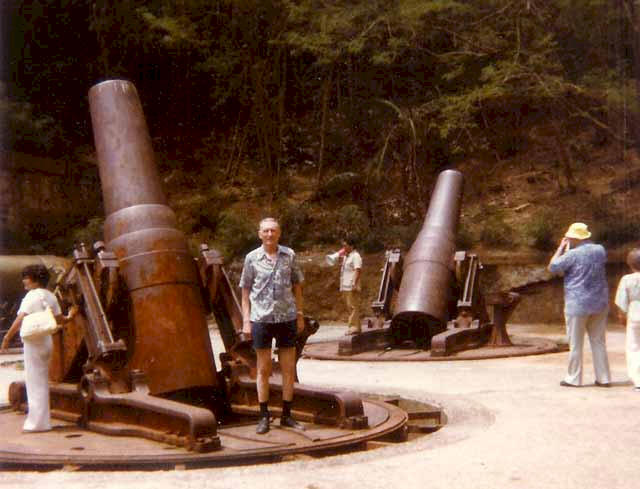|
Battery Way was constructed between 1904 and 1913 at a cost of $112,969 and named in honor of 2nd Lt. Henry N. Way, 4th U.S. Artillery, who was killed in action 28 August, 1900 at Villa Vieja, Philippines. Armed with four 12-inch (305mm) M1890 Mortars on M1896M1 Mortar Carriages, the mortars were capable of lobbing a 1,000 lb (454.5 kg) deck piercing shell or 700 lb. (318 kg.) high explosive shell 14,610 yards (8.3 miles or 13.35 km.) in any direction. Maximum bagged charge weight was 63 lb. (28.6 kg). Firing elevation was from 45 degrees minimum to 70 degrees maximum. Length of rifled bore is 10 ft. (3.05 meters). Rate of fire capability was one round per minute to one round in 45 seconds, but this was seldom met as the standard tactic was to load and lay two mortars at a time firing "in salvo" to achieve a shotgun effect. Standard crew per mortar was 14 men. Although designed to penetrate relatively thin deck armor of warships, their vertical plunging trajectories also made them ideal for use against an enemy entrenched on the higher ground of Bataan. Because concussion when fired tended to break medical glassware at the hospital located nearby, coupled with a shortage of personnel to maintain all the batteries, Way was placed out of service during peacetime. It remained unmanned until 17 April, 1942, when an anti-aircraft searchlight and radar unit, Battery E, 60the Coast Artillery under Major William Massello took over. No. 1 mortar (counted counter-clockwise from the far right) was totally unserviceable but by the 20th April, the men were able to proof fire mortars 2, 3 and 4. On 2 May, Nos. 2 and 3 were disabled by direct hits on the barrels, leaving only No. 4 serviceable. After midnight 6 May, this last mortar (Battery Geary had long since been totally obliterated) went into action against Japanese landing craft in the North Channel. Between 4:00 and 6:00AM, Way, together with three 155mm guns still in action on Corregidor and the four 14-inch (355.6mm) guns of Fort Drum dispersed an attempted landing at North Dock. Way continued firing all morning, despite a rain of shells dropping into the pit, seriously wounding Major Massello and causing 70 percent casualties amongst the gun crews. By about 11:00 AM, the barrel had overheated to such an extent that it could no longer be safely loaded and there was a pause in firing to allow it to cool down. It was then discovered that the breech block had frozen, warped by the heat from constant firing.
Irrespective of the pattern in which the mortars might be numbered, which still is confusing, this is the Mortar which last fired from Corregidor. The man standing with it is Staff Sergeant Walter Kwiecinski, AKA Finch, who was the last sergeant firing the last mortar at Battery Way. In 1980, he came to Corregidor and posed beside it. He would not have travelled half way around the world to stand by someone else's mortar. The identification of this mortar (as being the last to fire) was verified by "E" Battery members Ed Friese and Henry HArlan at the 2006 Phoenix ADBC Convention. (Information and image courtesy Steve Kwiecinski. At the risk of being called a revisionist, the 11:00 AM time, bears revision. It comes from the account of Maj. Massello, as published by the Belotes'. Others, particularly S/Sgt. Kwiecinski, have stated it was "more like sunrise", "around 6:00 AM." Considering that the mortar only fired about 130 shells, 6:00 AM makes sense. The Japanese artillery spotters were no fools, and if WAY was firing past sunrise they would have pounded the hell out of it. S/Sgt. Kwiecinski says that around sunrise, soon after Massello was hit, they were ordered to stop firing because they were hitting some of their own men on the beach. Coincidentally, the breech had expanded and could not be opened at the time. Massello was admittedly injured prior to sunrise. Well after the war's end, Massello was quoted as deferring to Sgt. Kwiecinski as to his truth of the matter. ( It may well be that not everyone will ever be satisfied with all that is recorded as happening there and at what time it did happen, but that is the quintessential "Fog of War.") The last of Corregidor's "Concrete Artillery" thus passed into surrender, and into history.
Battery Geary and Battery Way were armed with 12-inch mortars. Geary had eight, and Way had four. By 1941, these weapons were decidedly old. In the annals of bravery, one can't go past Batteries Geary and Way. Because the high trajectories of their mortars were able to put shells on the Bataan peninsular, the Japanese artillery made special effort to bring counterbattery fire upon them. Battery Way kept on firing until the day of the surrender, when its last mortar became so hot, it "froze" the breech. For the history of the unit which manned Btty Way, go to Btty "E" 60th Coast Artillery (AA). For a portrait of their CO jump to Major William "Wild Bill" Massello. For a Floor Plan, go to Floor Plan Battery Way. Dan Rowbottom's Battery Way page Dan has built a scale model of Battery Way.
|


